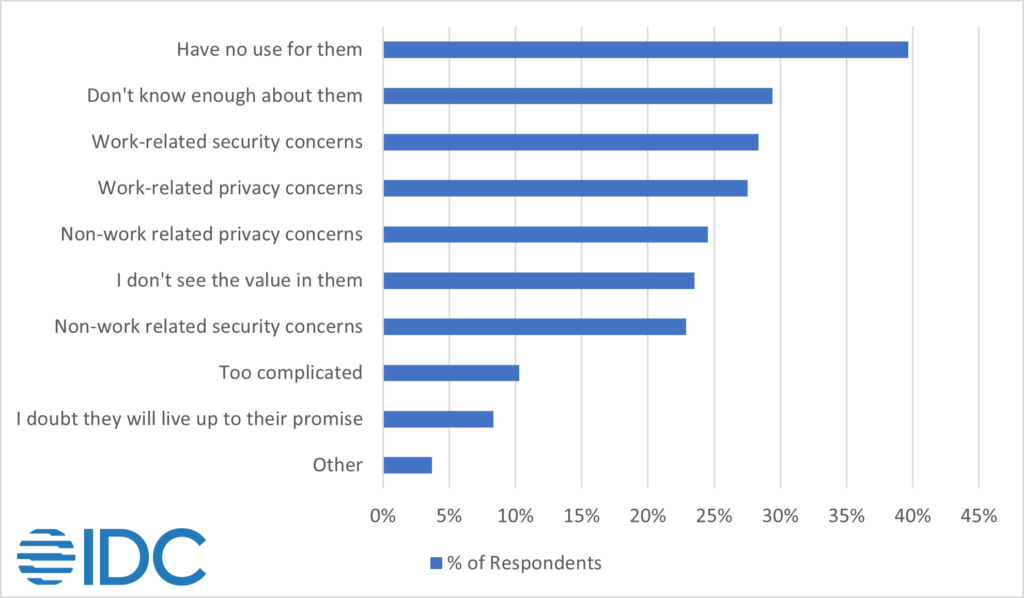Advances in wireless communications and IoT-enabled components — coupled with the advent of consumer-focused smart home devices like smart speakers, smart displays and others in recent years — have paved the way for new smart office solutions that dramatically enhance the ways in which work is conducted.
Smart displays can be used to help workers manage their calendars, conduct video calls, view pertinent information from business applications, and more. Smart lighting systems can help promote employee wellness while also reducing energy consumption. Even smart appliances like connected coffee makers and refrigerators are helping the workplace to become more automated and digitally integrated, which can help boost productivity.
The rising aptitude of smart home device users is paving the way for a more technology-ready and digitally competent workforce. This in turn not only drives business benefits like increased operational efficiencies, productivity, employee wellness and more, but also helps with the radically changed work environment caused by the pandemic and its shift to working from home or hybrid work environments.
Whether in the office or at home, smart office devices enable workers to be more efficient, organized, and connected with their coworkers. They help workers to get more work done, in less time. They help to save time on scheduling meetings, managing meeting rooms and equipment, managing calendars, accessing and sharing enterprise data and applications, and they help employees to better connect with others to share ideas and collaborate in the office and remotely. Smart office devices should be considered seriously by any organization that wants to maximize operational efficiencies, drive enhanced collaboration and productivity, and drive further benefits as part of broader digital transformation efforts.
But as enterprises explore smart office solutions and consider their impact across the business, uncertainties remain about the readiness of the people that will be using these devices and whether or not their engagement will be sufficient to justify the business investment and ultimately decide the success of deployments.
From the supplier perspective, ongoing marketing and education efforts are needed to help enterprise decisionmakers discover the value of smart office devices and assuage any deployment apprehensions along the way. But just as important is the need for broader education and buy-in from the workers that will be using these solutions at work and at home. Much of the training and education burden will be on the enterprise customer to ensure successful rollouts of smart office technologies, but vendors are in a prime position to drive the market forward via consumer education efforts.
Generally, consumer buy-in to smart office solutions will be gradual and, in many ways, mirrors the dynamics of the smart home market, which continues to be hampered by concerns around security, privacy, and a general lack of awareness of understanding of the benefits of connected devices in the home. Thus, this raises the question – how ready are consumers (ergo, workers) to engage with smart office devices?
Consumer Interest in Using Smart Office Devices
To explore consumer sentiments towards smart office devices, IDC’s 2021 U.S. Smart Home Survey asked consumers about whether or not they would be willing to engage with these devices in the home or at work. After restricting the sample to people that currently use or intend to use a smart home device and are currently employed, results indicate that 49% of respondents said they would be willing to use a smart office device for work purposes either in the office or when working from home (See Figure 1).
Figure 1: Smart Home Users’ Interest in Smart Office Devices
Q. Would you be willing to use smart office devices for work purposes, either in the office or when working from home?

That almost half of respondents are willing to use smart office devices is encouraging and indicates a sound level of interest amongst many consumers and, thus, workers to engage with smart office devices. Given that the survey is focused on smart home users and intenders, it is likely that the rise of the smart home has had a positive effect on consumer awareness, understanding, and comfort with using devices like smart speakers, smart displays, smart appliances, and other devices.
This can translate into interest and aptitude in using similar devices for work-related needs. Equally as encouraging is the fact that another 26% or respondents said that they were unsure about using such devices but didn’t rule them out completely. Even so, one-quarter of respondents were outright against using smart office devices. Thus, taken together, this indicates that much work needs to be done by vendors and employers to help convert attitudes amongst those that are unwilling or unsure.
Leading Inhibitions to Using Smart Office Devices
With the goal of better understanding the driving forces behind consumer inhibitions towards smart office devices, IDC asked those respondents that are unwilling or unsure about using them to provide reasons for their apprehensions (see Figure 2). The two leading inhibitors center around a lack of perceived need or use, and a lack of awareness or understanding. This clearly points to the need for greater marketing and education initiatives to help raise the profile of smart office devices amongst consumers and show them the ways in which such devices can be used to enhance their work experiences.
Rounding out the top five inhibitors are work-related privacy concerns, work-related security concerns, and non-work-related privacy concerns. Respondents also indicated that they generally don’t see the value in these devices, that they have non-work-related security concerns, and that these devices are just too complicated or simply won’t live up to their promise. Others are concerned about confidentiality being compromised; internet connection issues; being unclear about how well the devices will integrate with work systems, computers, and applications; or some just have no need due to their type of job, role, or industry.
Figure 2: Reasons for being Unwilling/Unsure About Using Smart Office Devices
Q. You indicated that you would not be willing or are unsure about using smart office devices like smart speakers and smart displays for work purposes. Why not?

The Road Ahead for Users and Vendors
The road ahead for enterprises and workers alike in their adoption of smart office devices is paved with both promise and uncertainty. There is much to be gained from using smart office devices, but a knowledge gaps and security/privacy concerns will remain as significant barriers to the market’s growth for the foreseeable future.
On the supply side of the market, vendors need to increase marketing and education efforts for both enterprises and consumers. Raising awareness of the benefits of smart office devices is crucial to not just enterprise decisionmakers seeking such solutions, but to the people who will ultimately be interacting with the devices. By helping to show consumers the ways in which smart office devices can be used to conduct video calls or obtain information or schedule meetings and organize calendars and more – much like they already do with their smart home devices at home – this can help raise awareness and help translate proficiencies with using smart devices in the workplace.
On the demand side, enterprises need to explore the ways in which smart office devices can enhance their operations and broader digital transformation efforts by carefully researching vendors and products to make informed decisions. Moreover, the adoption of smart office devices requires buy-in across decisionmakers ranging from the C-Suite to the heads of various lines of business, HR, and IT, Facilities and others.
The benefits obtained from deploying and using smart office collaboration devices and services are directly proportional to the education, training, and willingness of stakeholders to leverage these tools as part of their normal operations. Cultural changes will be required also. Workforces will need training and IT support to adapt to new work processes and tools enabled by smart office devices. Company cultures must change to promote the use of such devices as part of broader digital transformation and remote work efforts.
Furthermore, business and IT risks will need to be addressed. Internet-connected smart office devices heighten the need for protecting sensitive business data and information. Learn more about consumers’ adoption of and attitudes toward smart home and smart office devices and applications – including market drivers, inhibitors, leading use cases, and more – on IDC’s website.




